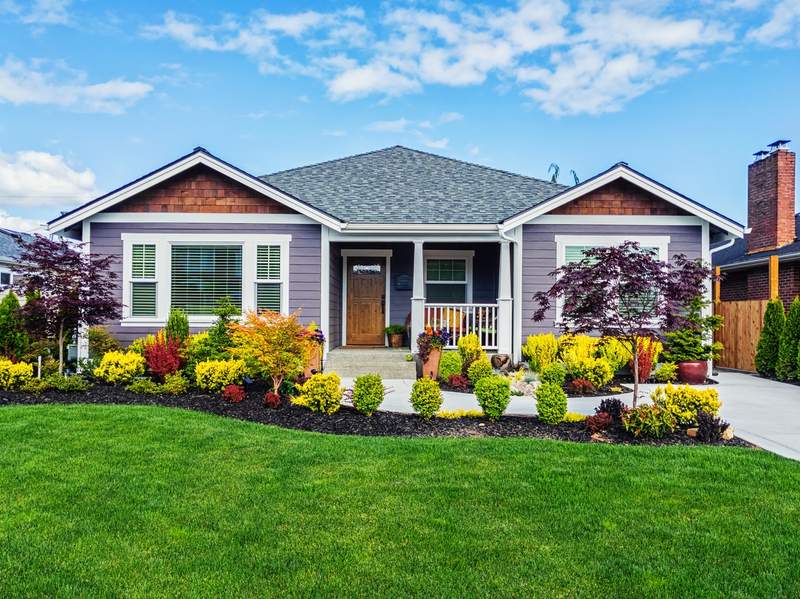How To Buy a House in 15 Steps
Buying a home is a long process with a lot of moving parts. To successfully buy a home, you need to understand the process and be prepared for each step.
1. Assess your finances
Evaluate your current income and spending to determine how much home you can afford. The goal is to figure out what you can reasonably pay for a home while still being able to afford other necessary expenses, such as food and health care.
Affording a down payment
To find out how much you can put toward a down payment, take your savings and set aside the amount you need for other savings goals, such as an emergency fund, moving costs, and home renovations.
In addition to the down payment, you need to pay closing costs upfront when you buy a home. Closing costs typically total 2% to 5% of the home’s purchase price. Estimate that sum and subtract it from your remaining savings to get the total amount you have available to put down on a house.
How much down payment do I need?
The down payment you need to buy a home will depend on how much the home costs, the type of loan you choose, and your credit score.
Some government loan programs, like those backed by Veterans Affairs and the U.S. Department of Agriculture, require no down payment but are available only to certain types of borrowers and for certain types of properties.
For most people, a Federal Housing Administration loan will offer the lowest down payment. Most borrowers can get an FHA loan with a down payment of 3.5%, though those with a lower credit score need a 10% down payment.
For conventional mortgages, borrowers need at least 3% for a down payment. Keep in mind that down payments of less than 20% generally mean paying for private mortgage insurance.
Down payment assistance programs
If you’re having trouble affording a down payment, consider looking into down payment assistance programs and resources. These programs usually are administered by state and local governments or nonprofit organizations.
For example, Boston has a grant program that offers up to $50,000 in down payment assistance to first-time homebuyers who make less than 100% of the area’s median income.
Affording closing costs
Closing costs include everything from compensating the lender for originating your loan to prepaying property taxes and homeowners insurance on your new home.
Closing costs run between 2% and 5% of the loan amount, and typically include:
- Origination fees.
- Appraisal fees.
- Attorney fees.
- Credit reporting fees.
- Mortgage points.
- Prepaid taxes and insurance.
- Homeowners association transfer fees.
- Title insurance.
- Mortgage insurance.
What credit score do I need?
Your credit score helps lenders evaluate your creditworthiness. A higher credit score suggests that you reliably repay your debts. It also improves your odds of getting approved for a mortgage, and of receiving a lower interest rate.
Though a credit score can be calculated in different ways, it’s usually based on:
- Your payment history.
- How much debt you have relative to your available credit.
- The length of your credit history.
- How many new credit accounts you’ve opened.
- Your credit mix, or the different types of debt that you have.
The minimum credit score to get a mortgage varies by loan type and lender:
Minimum Credit Score Requirements by Mortgage Type
| Type of Mortgage | Minimum Credit Score |
| Conventional loan | 620 for conforming loans. |
| FHA loan | 500, with a 10% down payment; 580, with a 3.5% down payment. |
| VA loan | No minimum credit score required by the VA, though lenders can set their own requirement. |
| USDA loan | No minimum credit score set by the USDA, though a score of 640 or higher is recommended. |
What’s my debt-to-income ratio?
Your debt-to-income ratio shows how much of your income is taken up by your debt obligations. Common debts include car loans, credit cards, and student loans.
Calculate your DTI ratio by adding up your monthly debt payments, dividing the sum by your gross monthly income, and multiplying by 100 to get a percentage. You also can use a DTI ratio calculator.
Limits on DTI ratios will vary depending on the loan type and lender. The lower your DTI ratio, the more income you have free to pay your mortgage. The ideal DTI ratio is below 36%, though it’s common for borrowers to qualify for a loan with a DTI ratio as high as 43%.
2. Know how much house you can afford
Once you’ve reviewed your finances and started saving for a down payment, it’s time to figure out how much home you can afford. Your monthly mortgage payment will include interest and principal on your loan, and also may include additional costs to pay for property taxes, homeowners insurance, and PMI.
Get pre-qualified
One good way to figure out how much house you can afford is to get pre-qualified. During pre-qualification, you give the mortgage lender some basic details about your credit and financial situation. The lender then gives you a rough estimate of the loan it expects you would qualify for, including the maximum amount you could borrow, the interest rate, and the monthly payment.
Keep in mind that pre-qualification is relatively informal. The lender won’t conduct a close investigation of your finances, so if the information you provide is inaccurate or incomplete, then the loan you’re offered when you officially apply will differ from your pre-qualification estimate.
Understand the cost of owning a home
There are many costs of homeownership. Some show up in your monthly mortgage bill, while others are less obvious.
Homeowners insurance
Homeowners insurance protects you and your property from financial loss caused by damage to your home from fire, storms, or other mishaps. Most lenders require borrowers to carry a minimum amount of insurance.
Prices vary widely based on location, the value of your home, and other factors. The average cost of a 12-month policy ranges from $999 to $1,655.
Most people pay for homeowners insurance with an escrow account, where the lender estimates the annual cost and collects a prorated amount every month that it uses to pay the premium on your behalf.
Flood and earthquake insurance
A standard homeowners insurance policy does not include coverage for damage or losses causes by a flood or earthquake. If you’re buying a home in an area that is prone to either, purchasing this coverage could save you thousands of dollars if disaster strikes. According to the Insurance Information Institute, 22% of homeowners reported being at risk of flooding, and over 37% of homeowners in the Western United States reported having purchased earthquake coverage.
Property taxes
Property taxes are assessed by local governments to fund basic municipal services, as well as public schools.
Property tax rates vary widely. Hawaii has the lowest average rate at 0.28%, while New Jersey’s is the highest at 2.49%.
As with homeowners insurance, most people pay property taxes with a monthly payment into an escrow account managed by their mortgage lender.
Home maintenance and repairs
Homes need regular upkeep and repairs to stay in good condition. This includes everything from installing a new roof to replacing old appliances that no longer work. A common rule of thumb is to budget between 1% and 4% of your home’s value each year for maintenance.
HOA fees
If you buy a home that’s part of a homeowners association, you must pay dues to fund community services and amenities such as trash removal, pools, parking, and exterior maintenance. Prices vary significantly, but typical fees are $200 to $300 a month.
3. List your wants and needs
Next, think about what you’re looking for in a home. Make a list of your wants, needs, and must-have features in a home, as well as features that would be nice to have but aren’t essential.
Types of homes
So, is a single-family home, condo, or townhouse the right choice for you? It ultimately depends on your budget, location, and preferred lifestyle. Let’s take a look at some of your options:
- Single-family homes. Houses tend to be larger than condos and townhouses with more outdoor space and autonomy when it comes to what you can do with the property — but also higher costs.
- Condominiums. You own one of multiple units in a building or other housing complex. Condos typically have an HOA that sets community rules and charges dues to pay for shared amenities. They are less expensive than many houses and require less maintenance, but you only own what’s within your unit.
- Townhouses. A nice middle ground between single-family homes and condos. These homes often have multiple stories and a small outdoor space. You’ll typically have more space than a condo but less outdoor space than a single-family home. Similar to condos, townhouses have one or two walls shared with another property and can be part of an HOA.
- Patio home. Typically one story high, but unlike a condo, the owner of a patio home also typically owns the lot the home sits on.
- Brownstone. A home that comes with a front-facing facade made of a dark sandstone and typically stands three to four stories high.
- Loft apartment. A loft apartment is a large open space that typically has high ceilings and few walls.
- Modular home. A home that is partially constructed in a factory and then shipped to the lot and placed on a permanent foundation.
- Manufactured home. A home that is built in a factory and is more mobile than a modular home but comes with fewer financing options.
- New-construction home. A home that has just been built, with or without your involvement, where you are the first inhabitant.
- Mansion. A larger, luxury home that’s typically at least 5,000 square feet in size.
Size, location, and features
For each home, imagine what it would be like to live in the area, and ask yourself a few questions:
- Do you want a home that’s move-in ready, or are you seeking a fixer-upper?
- Which features are essential to you? For example, think about the number of bedrooms and bathrooms you need, and whether you want a garage, large backyard, or pool.
- Do you want a place with plenty of space, or would you consider a tiny home in a great location?
- How long would your commute to work be?
- Is there convenient access to public transportation?
- What markets, restaurants, retail stores, and parks are in the neighborhood?
- If you have children, or are planning to have children, how good are the local schools?
4. Decide on a mortgage type
Choosing the right type of mortgage is important when buying a home. The type of loan you select can determine everything from where you can buy a home to the size of your down payment and how much you can borrow.
Conventional mortgage
Who it’s good for: Buyers with good credit who can afford a larger down payment — 20%, if possible.
Conventional loans are the most common type of mortgage. They come in two types:
- Conforming loans meet government-set limits on the loan amount and minimum down payment requirements. Conforming to these limits allows lenders later on to sell the loan to Fannie Mae or Freddie Mac, which are government-sponsored enterprises. This reduces the risk to lenders and helps make mortgages more affordable for more people.
- Nonconforming loans exceed the limits for conforming loans, which leaves lenders free to determine loan amounts, down payment requirements, and other features. Also known as a jumbo loan, this mortgage type usually is used to buy more-expensive homes. Eligibility is determined by individual lenders.
Pros and Cons of Conventional Mortgages
| Advantages | Disadvantages |
| Costs for conventional mortgages are typically lower compared with FHA loans. | The credit score requirements for conventional mortgages are usually higher than for FHA loans. |
| The minimum down payment for conventional mortgages is 3%. | PMI is typically required for down payments of less than 20%. |
| Conventional loans are widely available and offered by most banks, credit unions, and online lenders. | Nonconforming loans can come with higher interest rates and riskier features. |
| You can borrow more money if you meet the criteria for a jumbo loan. | You may not be eligible if you have too much debt. |
FHA loan
Who it’s good for: Buyers who don’t meet the requirements for a conventional mortgage.
The FHA backs mortgages made by private lenders. FHA loans require a minimum down payment of 3.5% for borrowers with a minimum credit score of 580, or 10% with a minimum credit score of 500.
Pros and Cons of FHA Mortgages
| Advantages | Disadvantages |
| Credit score requirements for FHA loans are typically more lenient compared with conventional loans. | FHA loans require mortgage insurance that includes both an upfront premium and an annual premium. |
| Compared with conventional mortgages, FHA loans tend to be cheaper for borrowers with lower credit scores and smaller down payments. | Loan amounts are capped at $498,257, or $1,149,825 in high-cost areas, for 2024. |
| Borrowers can put less than 20% down on a house. | Interest rates for FHA loans are usually higher than conventional loan rates when it comes to borrowers with good credit and a 10% to 15% down payment. |
| Flexible DTI ratio requirements. | The home must meet FHA property requirements regarding safety and security. |
VA loan
Who it’s good for: Eligible military service members, veterans, or their surviving spouses.
Veterans Affairs loans have no down payment requirement for qualified borrowers. However, borrowers get a discount on the mandatory VA funding fee if they put down at least 5%.
Pros and Cons of VA Mortgages
| Advantages | Disadvantages |
| Neither a down payment nor mortgage insurance is required. | Borrowers must meet minimum military service requirements. |
| There’s no minimum credit score set by the program, but lenders may set their own requirement. | Borrowers pay a VA funding fee, which ranges from 1.4% to 3.6% of the loan amount. |
| VA loans can offer competitive interest rates and limited closing costs. | Buyers with VA financing may encounter more resistance from sellers and agents who may prefer a buyer using another type of financing. |
| No prepayment penalty. | The home must be your primary residence. |
| Looser home eligibility requirements. | You could start out with negative equity on a home that is 100% financed. |
USDA loan
Who it’s good for: Borrowers who are buying a home in an eligible rural area and would otherwise be unable to get a mortgage.
USDA home loans are for low-income borrowers buying a qualified property in a rural area. Eligibility is based on income, as well as factors such as the property’s location and type.
Pros and Cons of USDA Mortgages
| Advantages | Disadvantages |
| USDA loans can help eligible homebuyers who lack access to safe and sanitary housing or other loan options buy a home. | The home must be in an eligible location, which generally means a rural area with a population under 35,000. |
| No down payment is usually required. | Borrowers must meet additional requirements concerning citizenship, income limits, property size and value, and more. |
| No mortgage insurance is required. | Upfront and annual guarantee fees are charged. |
| Low credit score requirements. | |
| No prepayment penalty. |
Other types of loans
There are other, specialized types of loans to consider.
For example, if you’re buying raw land and plan to build a home on it, you might consider a construction loan.
There also are mortgages offered by state housing finance agencies that typically are intended for lower-income homebuyers.
Here are some examples of additional types of loans:
- Construction loan. A short-term loan that covers the cost of building a home.
- Fannie Mae HomeReady mortgage. Geared toward low-income homebuyers with limited cash for a down payment.
- Freddie Mac Home Possible mortgage. Offered to very-low-to-low-income borrowers for a down payment as low as 3%.
- Good Neighbor Next Door mortgage. Offered to teachers, firefighters, and law enforcement officers with a discount of 50% off the home list price.
- Energy-Efficient Mortgage. Can be used to get more favorable mortgage terms to buy a home that has been deemed energy-efficient.
- HFA mortgage. Offered by housing finance agencies for homebuyers with very low, low, or moderate income — usually with flexible terms.
5. Decide on a mortgage term
Your loan term is how much time you have to repay your mortgage, with 30-year and 15-year terms being the most common options.
A 30-year mortgage offers monthly payments that are more manageable, but you’ll pay more interest overall. A 15-year mortgage requires higher monthly payments, but you’ll pay less interest and own your home in full sooner.
Interest rates for a 30-year mortgage usually are higher than rates for a 15-year mortgage.
6. Shop for a mortgage and get preapproved
There are dozens, if not hundreds, of mortgage lenders out there. It’s in your best interest to shop around and compare lenders to get the best deal.
Some common lender types include:
- Mortgage bankers. Most lenders are mortgage bankers. This includes banks and other companies that lend to borrowers.
- Good for: Borrowers who want to get the best mortgage terms from a reputable lender that they trust.
- Retail lenders. These are banks, credit unions, and other institutions that lend directly to consumers, handling everything from preapproval to closing.
- Good for: Borrowers who want an all-in-one lender to simplify the process.
- Direct lenders. Lenders that give loans to borrowers with no intermediaries are known as direct lenders.
- Good for: Homebuyers who want to avoid paying broker fees and have a direct relationship with their lender.
- Portfolio lenders. These are lenders that keep their loans on the books rather than selling them, allowing for more-flexible underwriting.
- Good for: Homebuyers who don’t qualify for traditional mortgage financing and are seeking looser credit requirements.
- Online lenders. This category contains fully online companies that often have lower-cost loans.
- Good for: Homebuyers who want to save money on fees and interest, and don’t need as much customer service attention.
- Credit unions. A credit union is a local, member-owned institution that may offer easier underwriting, and lower rates.
- Good for: Homebuyers who would prefer to work with a smaller, local lender that is familiar with that market and can offer more personalized customer service experience.
- Hard money lenders. Lenders that will issue you a short-term loan where you use an asset as collateral.
- Good for: Buying investment properties or homebuyers who need a bridge loan to finance their purchase while they sell their previous house.
- Correspondent lenders. Lenders who originate, fund, and sell a loan on the secondary mortgage market while continuing to service it.
- Good for: Homebuyers who want to keep a relationship with the same lender even if their mortgage gets sold.
Getting preapproved
When you’re serious about buying a house, you should get mortgage preapproval.
Preapproval is based on the lender’s assessment of your ability to repay the loan, which comes from examining your credit history, income, and assets. A mortgage preapproval letter indicates how much of a loan that particular lender expects you to qualify for. Preapproval typically is valid for 30 to 60 days.
While preapproval is no guarantee that you’ll get that loan, it assures real estate agents and sellers that you will be able to secure financing.
Remember, preapproval doesn’t commit you to working with a lender, so it’s a good idea to apply for preapproval with several lenders and compare the terms of their offers.
How to compare mortgage offers
When looking at loan offers, you should compare the interest rate, fees, and closing costs. Ask your lender to provide the annual percentage rate, or APR, which factors in all the costs of a loan. Use a mortgage calculator to figure out the monthly payment, and see which offer has the lowest overall cost.
Also, consider how easy the lender is to work with. If two loans are similarly priced, you might want to go with the lender that has a better reputation for good customer service.
Working with a mortgage broker can be a good way to get and compare multiple loan offers. Your broker will consider your finances and match you with the best lenders for your situation.
7. Find a real estate agent or Realtor
A real estate agent is a professional who’s licensed in your state to represent buyers or sellers in the sale of a home. Realtors are real estate agents who have joined the National Association of Realtors, and follow its standards and code of ethics.
It’s helpful to have a real estate professional on your side when buying a house. Your agent can advise you on how best to navigate the process, which may reduce the stress of trying to buy a home.
You can ask friends and family to refer you to real estate agents they’ve worked with. Alternately, you can search for real estate agents online. Local Realtors can be found using NAR’s directory of members.
Before you hire an agent or a Realtor, take time to ask questions and make sure they’re a good fit. Ask how they communicate with clients, how long they’ve been working in your area, what their schedule is like, and how long it typically takes them to help a buyer find a home.
8. Shop for a home
As you’re shopping around, try to tour different types of homes that fit your budget. Use your list of wants, needs, and must-haves in a home to guide you.
If you’re planning to move far from your current home, you also could look into how to buy a home remotely.
How to find homes for sale
The best way to find homes for sale is to work with an experienced real estate agent or Realtor. They know your area, and once you tell them what you’re looking for and what your budget is, they should be able to show you homes that interest you.
You also can use online listing services to browse homes for sale in your area.
What to look for when touring homes
When touring a home, consider how well it meets your needs and wants. Take note of the floor plan, number of bedrooms, and number of bathrooms, and think about how you could use other rooms in the home. For example, do you need a home office? Make sure there’s space for one.
Also, think about things like how much natural light the home gets; proximity to major roads, transit, parks, and businesses; availability of parking; yard size; and other aspects that will affect you on a daily basis. Consider if you can see yourself living in the home and using its features day to day.
What to do if you’re priced out of the market
If you get priced out of the market, you have a few options:
- Expand your search area. Home prices depend on many factors, but location is an important one. Consider shopping in a less expensive area to find a home you can afford.
- Save up a larger down payment. The more you put down on a home, the less you have to borrow to buy it, and the more affordable the monthly mortgage payment is.
- Let go of certain wants — or even needs. Over time, you can upgrade your home, or sell it to buy a new one once you’ve built up more savings and some home equity.
9. Make an offer and negotiate a deal
Your real estate agent or Realtor can help you make an offer on a home. If your offer is in the ballpark, expect a counteroffer from the seller, and you can continue to negotiate the home price. For example, you may want to ask the seller to pay some of your closing costs or make repairs as part of the sale.
Once the deal is finalized, both parties sign a purchase and sale agreement that outlines the terms of the sale and any contingencies required for the transaction to go through.
Making a strong offer
It’s important to come in with a strong offer that appeals to sellers.
One of the strongest things you can do is make a cash offer. Generally speaking, it doesn’t matter to the seller whether the money is coming from a loan or your bank account. However, paying in cash can provide a competitive edge in a situation with multiple offers on the table. That’s because a cash offer indicates the buyer already has the funds to purchase the home and can close quickly.
While it may seem intimidating to compete with a cash offer, keep in mind that cash buyers often back out of buying a home because they can compete more easily for other houses.
Consider an escalation clause
An escalation clause is an offer to beat a competing offer by a specific amount, up to a limit.
For example, you might write an offer that says you’ll pay $400,000 or $1,000 more than a bona fide competing offer, up to a maximum of $450,000. If no one else offers more than $400,000, then you get the home for $400,000. However, if someone else offers $425,000 on the home, then your offer automatically increases to $426,000. If someone offers $500,000, you don’t have to worry about breaking the bank.
An escalation clause can help you avoid paying more than you need to for a home. However, it also shows the seller the maximum you’re willing to pay for their home, which limits your negotiation power.
Writing a house offer letter
Another way that buyers try to make their offer stand out is to make an emotional appeal by writing a house offer letter.
A house offer letter typically explains in a personal way a little bit about who you are, why you want to buy the home, and why the seller should choose your offer. The hope is that in the case of two similar bids, emotions might work in your favor if you make a connection with the seller.
House offer letters are controversial, as they may reveal information about the buyer that would violate fair housing laws. While such letters remain legal, many professionals and organizations — including the National Association of Realtors — discourage their use.
What you can negotiate
In real estate, almost everything is negotiable. What your seller may be willing to negotiate typically depends on market conditions. It’s easier to negotiate in a buyer’s market than a seller’s market.
The most obvious thing to negotiate is the price of the home. If you offer less than asking, the seller still might accept.
You also can ask the seller to pay some of your closing costs or to make certain repairs that come up during the home inspection. If you like some of the furniture or appliances in the home, you also can ask the seller to include them in the sale.
10. Sign the purchase and sale agreement
Once the seller accepts your offer, it’s time to draw up and sign a purchase and sale agreement, which outlines the key details of the transaction.
Purchase price
Possibly the most important detail in the purchase and sale agreement is the price of the home. This is the total amount of money that you have to pay the seller to buy the home. Usually, you’ll offer deposits over the course of the sale process and pay the remainder at closing using a mortgage.
Contingencies
Contingencies are conditions that must be met for the transaction to close. For example, the buyer might add a contingency that lets them back out of the sale if the home inspection finds major defects. The seller might add a contingency letting them back out if they fail to find a new home to move to.
As a buyer, adding an appraisal or financing contingency protects you from overpaying or from buying a home that has hidden problems. But for sellers, such contingencies are opportunities for them to lose their buyer, so they often prefer offers that waive contingencies.
Closing timeline
The purchase and sale agreement sets the timeline for closing. This includes dates for paying deposits; completing the home inspection, appraisal, or mortgage approval; and closing.
11. Apply for a mortgage
It’s smart to shop around and get estimates from different lenders in advance, so that when you’re ready to apply for a mortgage, you’ve explored the different types of home loans and determined which one is right for your financial situation.
Fixed-rate vs. adjustable-rate mortgages
Fixed-rate mortgages have a set interest rate, which never changes throughout the loan term. With a stable monthly payment, borrowers can reliably budget their housing expenses for the term of the loan. Fixed-rate mortgages are ideal for buyers who plan on owning their home for a long time or who want to avoid fluctuations in their mortgage payment.
Adjustable-rate mortgages, on the other hand, typically start with a lower interest rate that applies for a set amount of time. Afterward, it can change at certain intervals according to market rates. If rates increase, borrowers will pay more interest. They may pay less interest if rates drop.
With an ARM, anticipating how much you’ll pay in the long term becomes more challenging. This mortgage option is suitable for buyers who are OK with potential rate increases or who plan on owning the property for a short while.
Documents needed
When you apply for a mortgage, the lender will require financial documents as part of the application. If you got preapproved, the lender likely will have many of these documents already — but it’s still good to have them on hand in case the lender asks again.
Expect to provide the following documents:
- Proof of income.
- Pay stubs.
- Tax returns.
- Wage or income tax documents, such as W-2 forms.
- Proof of self-employment income, such as profit and loss statements.
- Social Security benefits letters.
- Proof of assets.
- Bank statements.
- Brokerage statements.
- Other documents.
- Gift letters if anyone is giving you money to help with the down payment.
- Alimony or child support agreements.
- Paper records for recent large deposits.
- Statements for any other loans or regular bills.
After you submit a mortgage application, the lender has three business days to give you a loan estimate. This document estimates the interest rate, monthly payment, closing costs, taxes, and insurance for the loan you’ve been approved for.
Make sure to review the estimate closely to ensure that you understand it, that it matches your expectations, and that you can afford the loan being offered.
12. Get the home inspected and appraised
During the mortgage underwriting process, the lender will order a home appraisal and check the title for any claims against the property, such as unpaid taxes.
The appraisal is important because it determines the home’s fair market value. Getting the property appraised helps protect the buyer from overpaying, and allows the lender to verify that the loan amount is appropriate relative to what the home is worth. Lenders generally won’t lend a borrower more than a home’s appraised value.
It’s also important to schedule a home inspection as soon as possible, so you can find out if the home has any major problems. Depending on what the inspection finds, and the terms of your purchase agreement, you may want your real estate agent to renegotiate your offer or cancel the deal.
13. Mortgage approval
It’s a big moment when the lender decides whether to approve your loan. Once your loan’s approved, you’re almost ready to close the sale.
Understanding the closing disclosure
The closing disclosure lists the final costs of your loan and the transaction. It details the loan amount, the interest rate, the monthly payment, and all your closing costs. The lender is required to give you the closing disclosure at least three days before the scheduled closing date.
What to do if your mortgage application is denied
If your mortgage application is denied, you have a few options.
If you have a financing contingency in your offer, you can back out of the sale and likely get back your earnest money deposit.
If you still want to buy the home, call the lender and ask why your application was denied. See if you can offer a larger down payment, pay off other debts, or clarify some information you provided to get the lender to reconsider. If the lender refuses to change its decision, you can ask the seller to extend the closing date, and try to find another lender.
If you’re unable to get a mortgage, you might have to let the home go, work to improve your finances and credit, and try again later.
14. Pay closing costs
At this point, all that’s left to do is pay your closing costs and close the sale.
How to pay your closing costs
Usually, you pay closing costs on closing day. Because closing costs generally are tens of thousands of dollars, you’ll typically make the payment with a cashier’s check, certified check, or wire transfer.
How to reduce closing costs
There are a few different ways to reduce your closing costs:
- Choose a no-closing-cost loan. The lender pays the closing costs on these loans, and compensates by charging the borrower a higher interest rate.
- Negotiate with the home seller. Ask them to cover some of your closing costs. You also can negotiate with the lender about waiving some fees.
- Try to have your closing date near the end of the month. This limits the amount of prepaid interest you’ll need to pay.
15. Close on the home
Before signing anything, do a final walk-through of the home to confirm that all agreed-upon repairs or changes have been made.
On closing day, thoroughly read each document and check for any issues. Make sure to ask questions to your lender, your agent, the seller, or others if needed. Once you’ve confirmed that all the details are correct, sign the paperwork.
You should leave closing with a promissory note, a mortgage agreement, a deed to the property — and the keys to your new home.
Tips for Buying a New Home
Now that you’re familiar with the homebuying process, here are some tips on how to make the process easier to navigate:
- Compare mortgage offers. Always shop around to find a competitive offer and examine the interest rates and fees, as well as the terms, before accepting a home loan.
- Keep saving. Whether you’re saving for a down payment, closing costs, or emergency home repairs, you can stay prepared by making regular contributions to your savings accounts.
- Get properly insured. Make sure your property is adequately insured to financially cover you in the event of property damage, theft, or accidents. This includes insurance for floods, earthquakes, or other natural disasters if you live in an area prone to those events.
- Strengthen your credit. Having strong credit can help you in many ways when buying a home, and it also is helpful later if you want to refinance your mortgage. Keep working to improve your credit score by paying debts on time and in full each month.
FAQ for First-Time Homebuyers
Here are answers to frequently asked questions from first-time homebuyers.
While it may be obvious that a first-time homebuyer is someone who has never purchased a home before, you also meet the criteria if you’ve owned a home in the past but not in the last three years. Being classified as a first-time buyer could mean you’re eligible for certain programs that make it easier to purchase a home.
You need to weigh many factors when deciding if you’re ready to stop renting and buy a home. Owning a home can be rewarding, but it also is more complicated than renting.
Renters are required to pay the monthly rent, but they aren’t responsible for costs related to maintaining or repairing the property.
Homeowners, on the other hand, need to pay the cost of maintenance and repairs, as well as property taxes, homeowners insurance, and any HOA fees. Some of these expenses are tax-deductible, which makes them less expensive. Still, costs can vary widely depending on location and other factors.
The upfront cost of purchasing a home also is higher compared with renting. In general, homebuyers must make a significant down payment and pay additional closing costs.
If you’re thinking about buying a home, consider how long you plan to own it, the property’s long-term value, and how important homeownership is to you. It’s also crucial to evaluate whether your financial situation is secure enough to comfortably cover all the costs of homeownership, as well as any unexpected bills or emergencies.
Saving up for a down payment can take a long time, which might make you wonder if there are faster ways to buy a home. One option is to borrow money for your down payment — but you’ll need to be prepared for the additional debt, since you’ll be repaying another loan at the same time as your mortgage.
Here are different ways to potentially get a loan for your down payment:
— Personal loan. Certain types of mortgages won’t allow you to use a personal loan for a down payment, but others will. You may find it difficult to get approved for a mortgage if taking out a personal loan will overextend your finances.
— “Piggyback” second mortgage. This option allows people without much savings to borrow extra money — also secured by the home — to reach a 20% down payment and avoid paying for PMI.
— Family or friends. A family member or good friend may be willing to lend money to you for a down payment. This arrangement requires you to set clear expectations for repayment, and disclose the deal to your mortgage lender.
Here are some rookie mistakes made by first-time homebuyers that you’ll want to avoid:
— Buying more home than you can afford.
— Underestimating your closing costs.
— Underestimating the ongoing cost of homeownership — like maintenance, utilities, and repairs.
— Not shopping around and just going with the first lender you get a quote from.
— Skipping the home inspection.
— Rushing through the process.
— Not working with a real estate agent.
— Not making a large enough down payment.
— Not researching the neighborhood.
The Bottom Line on Buying a Home for the First Time
By understanding the steps to a home purchase, your mortgage options, and the true cost of owning a home, you can approach the process of buying a house with confidence. It also helps put you in a good position to save money. Every first-time homebuyer’s situation is different, so be sure to consider your own before choosing a mortgage lender and home that’s best for you.
More From LowerMyBills:
- Purchasing a Home: Free Resources and Tips
- Getting a Mortgage: How Much House Can I Afford?
- How To Save For a Down Payment in 6 Months
- Types of Mortgage Loans and Refinances Explained
- How To Find a Real Estate Agent
- What Are Closing Costs and How Much Will You Pay?
- The LowerMyBills Mortgage Comparison Tool
Jennifer Calonia and T.J. Porter contributed to the reporting of this article.
- Federal Reserve Bank of St. Louis (2023)
- Progressive (2023)






